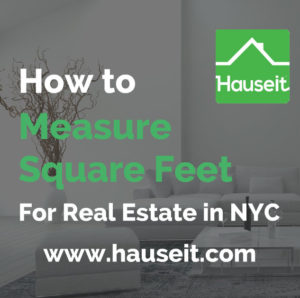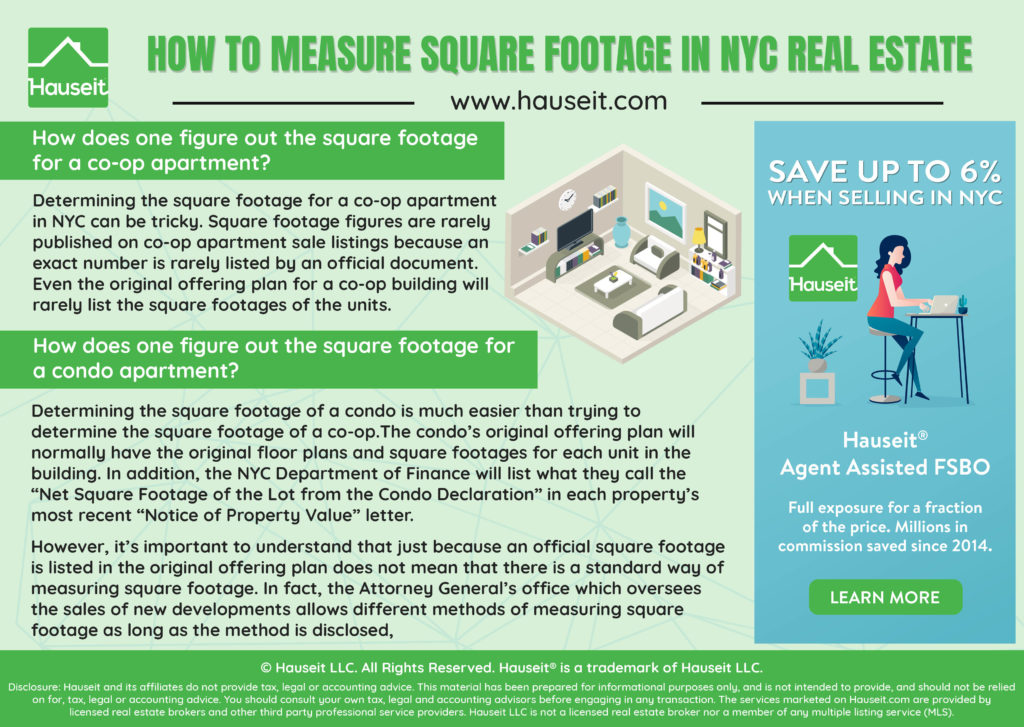What exactly is square footage? How is it measured and how do you find the actual square footage of a co-op or condo apartment in NYC? Are new development square feet measurements always inflated?
We’ll discuss everything you need to know about how to measure square feet and the nuances of finding a property’s real size in New York City.
Table of Contents:

What Is a Square Foot?
A square foot is a measure of area or size in real estate. Square footage is a two dimensional measure of space, meaning that height is not a factor because we are not measuring volume, which would be three dimensional. In other words, the square footage of a room is simply the amount of floor space.1
For your typical rectangular shaped room, the square footage would be calculated by simply multiplying the length of the room by the width of the room. For example, let’s say a legal bedroom in NYC must be at least 8 feet by 8 feet in length and width. That means the square footage of a legal bedroom must be 64 square feet at a minimum.
1We will discuss in later sections of this article on the nuances of measuring square footage for a condo, co-op or town house in NYC. Many developers will use more aggressive measurement tactics and include wall space or even common elements as part of a unit’s square footage.
A Full Service Listing for 1%
Sell your home with a traditional full service listing for just one percent commission.
How to Figure out Square Footage for a Co-op Apartment
Figuring out the square footage for a coop apartment in NYC can be tricky. Square footage figures are rarely published on co-op apartment sale listings because an exact number is rarely listed by an official document. Even the original offering plan for a co-op building will rarely list the square footages of the units.
Why Co-ops Don’t List Sq Ft
As a result, real estate listing agents have learned to avoid listing square footage estimates for co-op apartments due to many lawsuits by remorseful buyers over the years.
Admittedly, the reason for many of these lawsuits were due to highly inflated square footage figures by sellers and listing agents, typically 20% or more than the actual size.
With that said, it’s also highly beneficial for sellers to be able to list a square footage number for their sale. That’s because it gives a reference point for buyers in terms of valuation, and makes it much easier to compare their listing to other comparable listings.
How much space am I getting for the listing price is a perennial question asked by home buyers in New York City. As a result, some sellers may get a draftsman or architect to measure an exact floorplan and provide them with an estimate of the square footage of their home.
Or they’ll simply use the same square footage number that another seller of the same line in their building is using, typically without checking where the other seller got their information. Sellers who are intent on this approach would be well advised to consult their attorney and put a standard disclaimer on their listing:
Disclaimer: Square footage numbers are only estimates. If a potential purchaser is concerned about the square footage of the property, purchaser must engage a professional to assist him or her in calculating and understanding the methodology of calculating square footage.
How to Figure out Square Feet for a Condo
Figuring out the square footage of a condo is much easier than trying to determine the square footage of a coop.
That’s because condo sale listings almost always have a square footage number listed which you can also cross reference in multiple places. For example, the condo’s original offering plan will normally have the original floor plans and square footages for each unit in the building listed.
Furthermore, the NYC Department of Finance will list what they call the “Net Square Footage of the Lot from the Condo Declaration” in each property’s most recent “Notice of Property Value” letter. This letter is a public record that can be found for any real property in the city simply by searching on the NYC Department of Finance website.
However, it’s important to understand that just because an official square footage is listed in the original offering plan does not mean that there is a standard way of measuring square footage.
In fact, the Attorney General’s office which oversees the sales of new developments allows different methods of measuring square footage as long as the method is disclosed, along with a disclosure that the square footage number may be more than the square footage buyers can actually use.
The lack of a standard measurement process means developers have great flexibility to inflate their units’ square footages for marketing purposes. It’s fairly common to see developers today measure square footage from the outside of the building’s exterior wall. Interior walls that are shared with other apartments are typically measured from the halfway point to give equal credit to each unit.
Even more egregiously, many developers will include an apartment’s proportionate share of the building’s common elements such as hallways in the stated square footage. As a result, this is why you’ll see some corner units in buildings with thicker than average exterior walls have usable square footage that is sometimes 15% less than the published square footage!
Be careful and read the offering plan to determine how square footage is measured before buying a new construction home in NYC!
Get a 2% Rebate When You Buy
Save thousands on your home purchase with a buyer agent commission rebate from Hauseit
Determining Square Footage for a Townhouse
How do you determine the square footage of a townhouse, multi-family property or single family house? Most smaller, free-standing property will be individually owned and will not have an offering plan to reference off of. So how can you determine the square footage?
Fortunately, an estimate can be found for most free-standing property in NYC by looking at the property’s Notice of Property Value letter from the Department of Finance. You’ll notice that instead of referencing the condo declaration, the letter will say that the figure is the “Estimated Building Gross Square Footage.”
As we’ve previously discussed, this is a public document that you can easily find for any real property on the NYC Department of Finance Website.
Alternatively, you can search for the property’s address on NYCityMap, which is a handy database maintained by the NYC Department of Information Technology & Telecommunications. When you search for the property’s address, you’ll be able to find something like “Gross Floor Area: 3,200 sf (estimated)” for the city’s estimate of the property’s size.
Save 2% On Your Home Purchase
Save thousands on your home purchase with a buyer agent commission rebate from Hauseit
Disclosure: Commissions are not set by law or any Realtor® association or MLS and are fully negotiable. No representation, guarantee or warranty of any kind is made regarding the completeness or accuracy of information provided. Square footage numbers are only estimates and should be independently verified. No legal, tax, financial or accounting advice provided.






